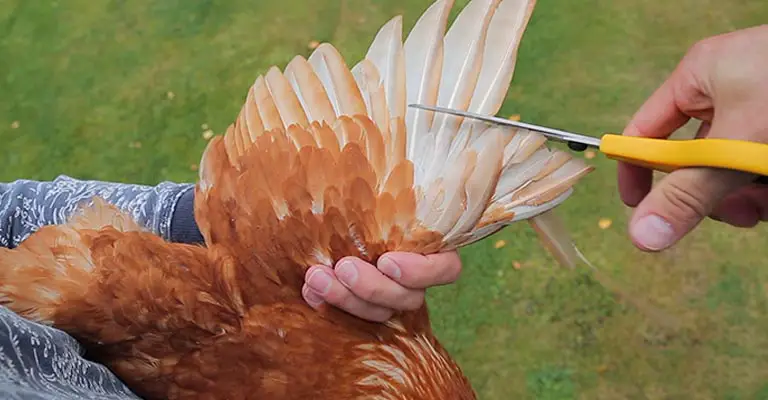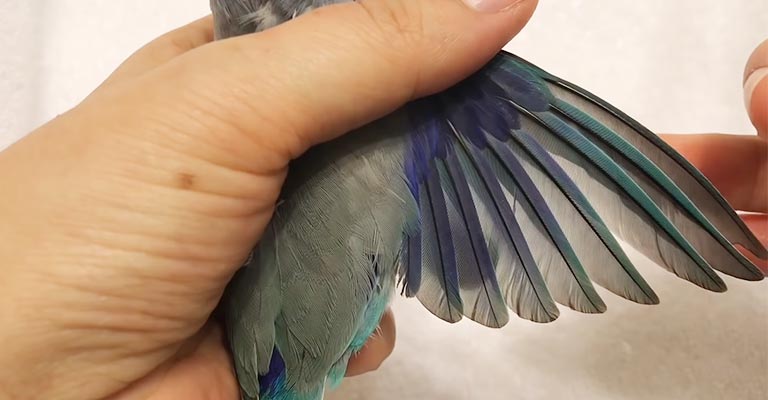Do you have birds? Then, you must want them to hover over the ground and walk a bit with you. If you leave them without clipping their wings, they can seriously injure themselves.
Take an example of me! I can’t take my birds out due to the ceiling fan, what if they hurt themselves? Cause when you bring them out, they would fly or attempt to fly (for the chicks).
Leave them be, they can bump themselves into the wall or even badly cut themselves. That’s why it is essential to clip the bird’s wing. If you haven’t done it before, don’t worry, we are here to guide you!
It may take a while to get used to the process, remember to follow our wing clipping guide for bird owners when you need help!

You Should Know
- Wing clipping has been a common practice. It should be done with care. A slight mistake can lead to injury or distress for the bird.
- Do some research before you decide to clip. Because not all birds need the same amount of wing clipping. Some birds may not need clipping at all.
- Clipping wings is a temporary measure. The feathers will molt and regrow. So, it is not a permanent solution to prevent flight.
- You should clip wigs every 1-3 months after the molt cycle begins. However, some birds may need frequent clipping while some less often.
- Don’t over-clip! It can poorly affect the birds and result in balance issues. They will fail to perch or move around comfortably.
- Some birds, like parrots, can become more prone to obesity after wing clipping because they are less active.
- It can affect birds’ behavior. If you notice any strange behavior with clipping wings, you should stop!
Here are a few basic starter points to clip birds’ wings. Let’s get into the details in the next part.
Wing Clipping Guide for Bird Owners

Remember that, wing clipping is no permanent solution. You will need to repeatedly do it after a few months. It is used for birds’ safety and no less than that.
If this is your first time, look for a change in behavior or activity in birds. You should also learn how it’s affecting your birds.
Also, you must monitor the growth of feathers after wing clipping. Birds should be sound and healthy during and after the whole procedure.
So, When Is The Right Time To Clip Wing?
Many of us often can’t understand the right time to clip the wings. Some believe the ideal time to clip is when the birds are mature and ready for breeding.
However, while different concepts of timing are available, experts suggest once the birds start to spread their wings, that’s the right timing.
Let the young birds learn to use their wings and reflex wing muscles a bit before you clip them. They should learn to flap their wings and use their tails, the basics of flying.
If you bring birds who have been clipped before, allow them some time to adjust before you clip their wings again. Take this time to observe the birds and how they fly. It will help you decide how much clipping is needed.
Remember, you should seasonally clip wings once you start it. If you stop all of a sudden, birds may not feel comfortable. They will have a hard time getting used to full feathers. You may notice some behavior changes in them.
Most bird owners clip bird’s wings before summer begins to help them cope with the heat. Generally, you can clip wings 3 or 4 times a year but not more than that.
How to Clip Wings in Birds?

Let’s find out how to clip wings in birds. If this is your first time, carefully follow the steps with us, and don’t shake your hands! 😀
- You will only need a few handfuls of tools. Such as a pair of sharp, clean scissors, soft towels, and a friend to assist you in holding the bird safely. Also, keep some styptic powder around you in case of accidental cuts.
- You never cut the secondary feathers. Wing clipping only involves the primary feathers. Before you start, you should be 100% certain of the feathers. The secondary feathers are generally shorter with blunt ends.
They are broader than primary feathers. Meanwhile, primary feathers are the outermost feathers. You will have to trim these feathers only. Learn more about Birds’ Feather Identification. - Now, use a soft towel to hold your bird. Be gentle but also hold your bird firmly so that, the bird can’t move frequently or struggle too much. Focus as you may harm the bird unintentionally. Take help from your friend if you have to.
- You are going to trim the primary feathers of both wings. Make sure not to cut too close to the feather shaft. It may put the bird in discomfort or the bird may bleed if not careful. Generally, it’s only the first 6-7 feathers on each wing that needs to be clipped.
- Once you are done, release the bird slowly as it may feel a bit unsteady to get used to. The bird will take some time to adjust to the new bodily balance.
Notice the bird a few more times and make sure it can still glide to the ground safely without harming itself.
If you have other birds continue the same way. Adjust the clipped lengths differently if you have to since all birds are not the same. After completion, clean your hands properly and keep the materials away safely.
Every bird is different. So, they may react differently to wing clipping. Pay attention to each bird and observe how they behave. Birds should still be able to maintain some balance and have control over flight.
Another thing you should never miss is, to confirmly ensure the regrowth of feathers.
A Piece of Advice
Some bird owners may not choose to clip the wings as it restricts the natural behavior of birds.
Instead, they focus on practice and invest their time in training the birds. It may take some time, but the result is marvelous and comes in full form!
On the other hand, wing clipping is done for the safety of birds. It should ensure domestic birds won’t harm themselves and you can also leave them open for some time without having to worry.
Additionally, comes the training part! Birds with clipped wings are easier to train and manage, for rookie bird owners.
Because it is not usual that, amateur bir owners often harm the birds while chasing them and holding them wrong!
Have you clipped birds’ wings before? Let us know in the comment section. We can help you out!